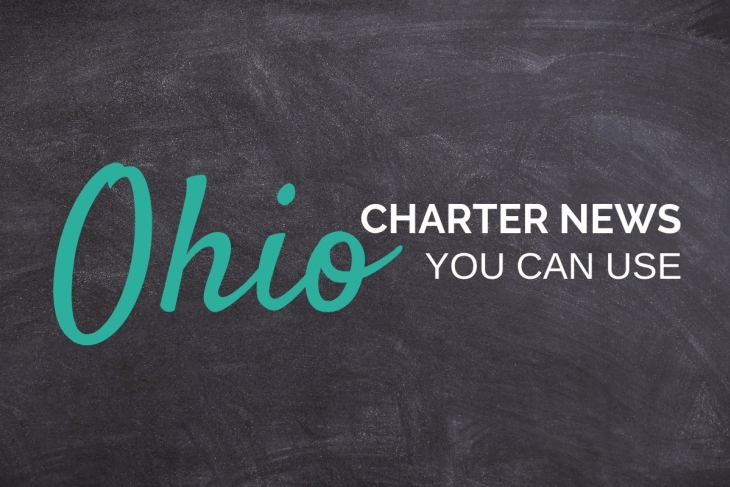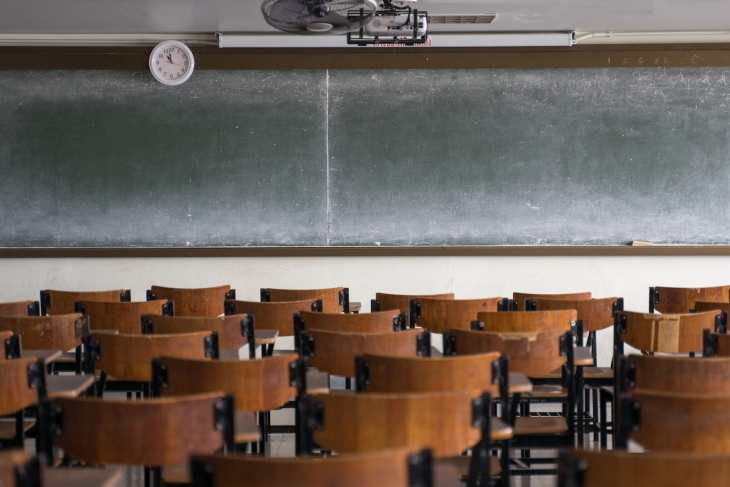- Partisan overtones in the National School Boards Association’s letter to President Biden has led many members to withdraw or refuse to renew their membership. —Washington Post
- “The empty pageantry of education research.” —Rick Hess and Mike Goldstein
- In his first year, Secretary Cardona has managed to improve relations between the U.S. Department of Education and districts, but critics feel he didn’t prioritize students and reopening enough. —The 74
- “The volatile debate over how to teach about America’s racist past is wreaking havoc on states’ processes for deciding what students will learn about history and social studies.” —Education Week
- An interesting discussion of the importance of education in the Black community comes to us from Lima. Local entrepreneur Jeffrey Kirkman reiterates that Black families want and deserve the best for their children but data show that traditional district schools are not working for many Black youth. He is a fan of the EdChoice Scholarship Program for this reason. Neither Mr. Kirkman’s strong support nor his reasoning therefor are allowed to stand by themselves, as you no doubt guessed, because this is Ohio journalism. I’ll leave it to you to see who pops up to counter his statements and the somewhat novel argument used. (Lima News, 1/15/22)
- Speaking of Ohio journalistic no-brainers, both the reason for creation of Academic Distress Commissions (years, sometimes decades, of unrelenting academic suckitude) and the hard-fought resistance to ADC improvement efforts by entrenched local interests have been nearly entirely erased in this piece. It’s almost too cliché to bother remarking on, really. However, this discussion of what East Cleveland City Schools and Lorain City Schools have planned to help them finally shake off that “unfair” and “unsuccessful” ADC control. (Youngstown City Schools is likely still a bit too radioactive to fit into this story and is thus also shunted to the side.) Kudos, I suppose, to current East Cleveland CEO Henry Pettiegrew for at least admitting that his students’ test scores—and reading levels—have been wretched over many many years. But now that state oversight is waning and he and his elected board at last have a chance to fix those long-standing failures to educate students, what’s the big plan? A giant hunk of a remote, asynchronous learning. Yes, you read that right. “Pettiegrew is calling this next semester before that July start date their ‘preseason’,” the article tells us. “As a part of that, every Monday — they're calling it Mindful Monday — the students are learning remotely. They’re meeting virtually with groups, learning asynchronously, meeting with school counselors and psychologists.” Nope. I don’t get it either. (Ideastream Public Media, Cleveland, 1/18/22)
- Meanwhile, out in suburbia, high school junior Mohammad Zoraiz hacked an existing math app and built his own variation designed to help his fellow students boost their skills on their own. (He was regularly asked by teachers to help tutor others.) He also won a first place award in the 2021 Congressional App Challenge and provided all the photos used in this article. Is there nothing this young man can’t accomplish? I think not. Kudos! (WKYC-TV, Cleveland, 1/13/22)
Did you know you can have every edition of Gadfly Bites sent directly to your Inbox? Subscribe by clicking here.
If you’re at all involved in Ohio education policy, you’ve heard about the anti-voucher lawsuit that was recently filed by the Ohio Coalition for Equity and Adequacy of School Funding. The coalition, which is made up of dozens of traditional public school districts, hopes that a victory will spell the end of the EdChoice Scholarship Program, which served over 50,000 kids during the 2020–21 school year.
The lawsuit opens with the assertion that EdChoice poses an “existential threat” to Ohio’s public school system. The claims that follow outline several arguments in favor of abolishing the program. My colleague Aaron Churchill recently did a very thorough and efficient job of debunking the lawsuit’s claim that EdChoice has created an inequitable funding system. But there are a few other erroneous claims that also deserve rebuttals. And one of the most significant is that EdChoice is unconstitutional.
Most of the plaintiffs’ case is predicated on Article VI, Section 2 of the Ohio constitution, which reads: “The General Assembly shall make such provisions, by taxation, or otherwise, as, with the income arising from the school trust fund, will secure a thorough and efficient system of common schools throughout the State; but, no religious or other sect, or sects, shall ever have any exclusive right to, or control of, any part of the school funds of this State.”
The plaintiffs’ arguments against this provision can be boiled down to this: First, the expansion of EdChoice has, in their words, “created multiple state-wide systems of publicly-funded, uncommon, private schools.” The program offends the constitution in doing so, as they believe the law “authorizes the state only to fund a thorough and efficient system of common, i.e., public, schools.” Second, because many of the private schools that participate in EdChoice are religious, the lawsuit claims that the program violates the Ohio constitution by “placing hundreds of millions of dollars in school funds within the exclusive, unfettered control of private (mostly religious) institutions.”
Both arguments miss the mark, and here’s why.
A thorough and efficient system of common schools
This argument hinges on an assumption, which is that the phrase “common schools” means traditional public schools and only traditional public schools. Given that the historical common schools movement is predicated on the notion that every child should have access to free public schools, it’s not altogether surprising that the plaintiffs have gone in this direction. But ultimately, arguing that the constitution’s mandate for “a thorough and efficient system of common schools” means the state can only fund traditional public schools is misguided for two reasons.
First, the constitution calls for the state to fund a system of common schools. And a system, by definition, is “a regularly interacting or interdependent group of items forming a unified whole.” Ohio’s current education landscape is made up traditional public districts, charter public schools, STEM schools (which are public but operated independently of a district), and private schools. These schools are unified by a common goal to educate kids, and the ability of Ohio families to choose where to send their children means schools must regularly interact with each other and the community. Ohio’s schooling landscape—and the diverse options that are part of that landscape—clearly fit the definition of a system.
Moreover, there is no provision within the constitution that requires schools within the mandated system to operate under the same governance structure. In fact, it’s widely accepted that systems have different and unique parts. The human respiratory system, for example, is made up of the mouth and nose, the sinuses, the pharynx, and the lungs. Each part is responsible for helping our bodies breathe, but they don’t accomplish that goal in the exact same way. If they did, they wouldn’t be a system—they would be a group of identical parts. The same is true for education. Traditional district, charter, STEM, and private schools that accept vouchers reach their shared goal in distinctive ways, but striving toward the same goal makes them a system. So, too, does the fact that they all must meet the same health and safety guidelines, administer annual state tests, and hold students to the same graduation standards.
Second, the lawsuit overlooks an important precedent. In 2001, a group of traditional public school advocates filed a lawsuit alleging that Ohio’s charter school law was unconstitutional. They claimed that charters—referred to as “community schools” in law—weren’t part of the common school system. In 2006, the Ohio Supreme Court upheld the constitutionality of the law and ruled that the General Assembly had not transgressed the limits of its legislative power. Writing for the majority, Justice Judith Ann Lanzinger explained: “In enacting community school legislation, the General Assembly added to the traditional school system by providing for statewide schools that have more flexibility in their operation. Community schools were designed to give parents a choice.” She added that “the expressed legislative intent is to provide a chance of educational success for students who may be better served in their educational needs in alternative settings.”
It’s not difficult to see how this could be applied to the recently-filed voucher lawsuit. In enacting EdChoice legislation, the General Assembly didn’t abandon the traditional public school system. In fact, lawmakers have continued to support and fund Ohio’s traditional school districts at increasing levels over the past two decades. All they did was add more educational options that empower families to choose schools that best meet the needs of their children.
Religious schools
The second half of Article VI, Section 2 relates to religion. The plaintiffs argue several times that because students can use a voucher to attend a religious school, the state is thereby funding religious entities. But that claim runs counter to a precedent set by the U.S. Supreme Court. In 2002, the Court ruled in Zelman vs. Simmons-Harris that the Cleveland Scholarship Program didn’t violate the Establishment Clause. Chief Justice William Rehnquist wrote that the program “is entirely neutral with respect to religion” and that it “provides benefits directly to a wide spectrum of individuals.”
This same reasoning holds true for EdChoice. Any and all Ohio private schools, regardless of religious affiliation, are welcome to participate. The program doesn’t prioritize religious schools, and a program that is “neutral with respect to religion” cannot and does not provide “an exclusive right” to state funds. Furthermore, because EdChoice scholarships are given to families—a “wide spectrum of individuals,” to use Justice Rehnquist’s words—rather than to private schools, the state can’t be accused of funding private schools, religious or otherwise. The lawsuit asserts that EdChoice places “hundreds of millions of dollars in school funds within the exclusive, unfettered control of private (mostly religious) institutions.” But based on what the U.S. Supreme Court decided two decades ago, that’s not true. Voucher programs like EdChoice place funding in the hands of families who then make a choice about which school their child will attend. It’s through families, not the state, that taxpayer funds reach private schools.
***
It’s telling that this lawsuit opens with a declaration that EdChoice poses “an existential threat” to public schools. It makes the plaintiffs’ intentions crystal clear. This isn’t about kids, or families, or communities. It’s not about making sure that every kid has a chance to attend a school that will meet their needs. It’s about giving a particular set of schools—and a particular group of people—an opportunity to reclaim a monopoly on state funding regardless of how well they serve kids. Ohio families deserve better than that.
Last week, five school districts filed a lawsuit in the Franklin County courts that attempts to strike down EdChoice, Ohio’s private scholarship program that serves roughly 50,000 school children, many of whom are among the neediest kids in the state. The plaintiffs allege that offering these scholarships harms public school systems and thus offends the state constitution. The complaint, however, is riddled with sketchy data and questionable arguments, and it omits solid research evidence showing that EdChoice, like kindred scholarship programs across the nation, actually has neutral to positive effects on public schools. Predictably, the lawsuit also ignores the program’s benefits to the families who now have the opportunity to choose schools that better meet their children’s needs.
Amid their many distortions, the plaintiffs’ most deceptive claim is that students attending traditional public schools receive less funding than scholarship students. They contend that:
Under H.B. 110, the Ohio Department of Education must pay $5,500.00 for each EdChoice voucher recipient in grades K-8, and $7,500.00 for each EdChoice voucher recipient in grades 9-12. In contrast, the average per pupil foundation funding allotted to public school districts is an average of about $4,008.00 per pupil for FY22. This amount is less than the least expensive EdChoice Voucher.
This disparity in funding is even more pronounced for the students attending schools in many of the Plaintiff Districts, where those students receive thousands of dollars less in state foundation funding on a per-pupil basis than their similarly situated voucher recipient counterparts.
This boils down to a claim that school districts are victims of an inequitable funding system. That would be worrisome if it were true. But it isn’t. The plaintiffs distort the truth by omitting key funding policies and the billions of dollars that those policies generate for traditional districts. Consider what the plaintiffs either missed or chose to ignore.
First, as part of the state foundation program, Ohio requires local districts to levy at least a 20 mill (or 2 percent) property tax. Those state-required dollars are excluded from the district funding amounts presented by the plaintiffs. In conjunction with direct state formula funding, this statutorily-driven tax ensures that all Ohio districts have sufficient baseline resources. As such, it’s a policy that cannot simply be ignored in debates about whether Ohio is meeting its constitutional obligations. Unfortunately, the plaintiffs do exactly that—omitting these foundational dollars—perhaps in an effort to manufacture a problem that doesn’t actually exist.
As Table 1 indicates, when the required property tax is included, the alleged inequity goes away. Combining state formula aid with the state-mandated property tax (which is built into Ohio’s entire school funding system), traditional districts receive on average $8,654 per pupil. That’s more than twice the district average that is cited by the plaintiffs ($4,008 per pupil) and above the scholarship amounts. The table below also illustrates the “progressiveness” of Ohio’s funding formula. It recognizes the uneven property wealth across districts and intentionally distributes more state aid to those that raise smaller amounts through property taxes. Among the five plaintiff districts, for instance, Lima and Barberton receive the most formula aid from the state—$11,530 and $8,526 per pupil, respectively—which more than offsets the smaller amounts that those districts generate on a 2 percent property tax.[1]
Table 1: Plaintiff districts’ state funding amounts, plus the state required 2 percent property tax

† I calculate these figures by dividing a district’s net state formula funding, as reported in the Ohio Department of Education’s January 7th payment reports for FY 22, by its FY 22 enrollment. The use of FY 22 funding data ensures that district amounts are comparable to the EdChoice scholarship amounts cited by the plaintiffs, which first applied in FY 22. * I calculate these figures by multiplying a district’s property values, as reported by the Ohio Department of Taxation for the 2020 tax year (TY 20), by 0.02. Data from TY 20 are the most recent available.
Second, subject to local voter approval, school districts have the authority to levy additional property taxes, i.e., more than 2 percent. Although these discretionary dollars could be seen as being outside the state foundation program, they generate millions more in revenue for traditional districts. The vast majority of districts do this, and the average property tax rate statewide was 3.64 percent (or 36.4 mills) in TY 20. When discretionary property tax dollars are added—none of which support private school students—we see district funding rise even more. Table 2 includes these dollars (which are also excluded by the plaintiffs). It shows that district funding statewide and in the five plaintiff districts easily exceeds the EdChoice scholarship amounts by almost $5,000 to more than $10,000 per pupil.
Table 2: Plaintiff districts’ state and local taxpayer funding combined

* I calculate these figures by multiplying a district’s property values, as reported by the Ohio Department of Taxation for TY 20, by the difference in a district’s effective property tax rate and 0.02. Data from TY 20 are the most recent available.
Third, overall spending on traditional district students’ education far exceeds EdChoice scholarship amounts. If anything, scholarship students are the ones who are treated unfairly. In the end, what matters is the overall resources available to educate students—not necessarily where the dollars come from. When it comes to overall spending totals—here including dollars generated from federal, state, and local sources—Barberton spent $14,762 per pupil in FY 21, Cleveland Heights University Heights spent $21,669 per pupil, Columbus spent $13,930 per pupil, Lima spent $16,113 per pupil, and Richmond Heights spent $18,094 per pupil. The plaintiff districts’ spending figures all exceeded the statewide district average that year ($13,387 per pupil) and were about two to three times the EdChoice scholarship amounts.
***
School funding is—and has long been—a joint effort between the state and local districts. In fact, the ability to raise money locally is often viewed as central to the cherished notion of “local control.” As the lawsuit moves forward, the courts must do a more comprehensive analysis of district funding that recognizes the state-required property tax—which ensures every district contributes its fair share—and looks at money generated via all taxpayer sources. If they do this, they’ll soon see that the plaintiffs’ story is a work of fiction.
[1] The plaintiffs’ complaint appears to rely on funding projections, as it was filed prior to the first payments made under the new formula in FY 22. That may explain differences in their figures versus my calculations. FY 22 state funding for Cleveland Heights-University Heights and Richmond Heights are likely affected by an anomaly in the FY 21 funding system (a suspended formula) and the phase-in of the new formula. Under a fully implemented formula, both districts would receive more than $3,000 per pupil in state aid according to June 2021 projections from LSC.
Groveport Madison Local Schools have sued the state of Ohio in response to a massive fine levied upon them for failing to properly transport resident charter and private school students over more than two weeks last school year. The case argues that aspects of the state’s definition of “noncompliance” are arbitrary and unconstitutional. We learned from the same coverage that four other districts were similarly fined last year as well: Columbus City Schools, Cincinnati City Schools, Cleveland Metropolitan School District, and Elyria City Schools. Given the stern warning issued by the Ohio Department of Education and the more stringent legislation passed by the General Assembly last year, this appears to be a challenge to the state’s commitment to transporting all eligible students regardless of school attended.
Giving students what they need
Staff at Utica Shale Academy in Salineville, Ohio, recently created an outdoor welding lab at the school in order to speed up access to newly-donated welding machines. Not only will students immediately begin gaining hands-on experience, they will also be working in situations more resembling the real world environments of the oil and gas industry for which they are training.
Diverse, inclusive options
AM NY this week published a nice feature on charter schools in New York City. While it was a simple “explainer” style piece, the lauding of charters as diverse and inclusive options for families looking for a new or different fit for their children was clearly expressed. Likely very helpful to parents and guardians who had not considered charters previously.
Upcoming webinar on ESSER III funding
The National Alliance for Public Charter Schools is holding a webinar next week titled “ESSER III Funding and Fiscal Responsibility”. Supported by Amazon Business, the event aims to provide insights into the current status of funding distribution, share best practices from school leaders on how to stretch this funding, and provide resources on tracking spend to meet potential reporting requirements. Registration for the event, to be held January 19 at 1:00 pm ET, is here.
2022 National Charter School Conference
The annual National Charter Schools Conference is scheduled to be held in Washington, DC, June 19-22, 2022. This year’s event will center around three issues: The future of teachers, education, and charter schools; Impact of the pandemic on learning outcomes and mental health; and engaged and diverse advocacy. For more information and to register to attend, click here.
*****
Did you know you can have every edition of the Ohio Charter News Weekly sent directly to your Inbox? Subscribe by clicking here.
- Ohio is one of 19 states whose state chapter withdrew from the National Association of School Boards last year in reaction to….well, you know. A Washington Post piece published yesterday timelines the affair and notes several high-level Ohio connections along the way. (Washington Post, 1/13/21)
- Well, I don’t know about you, but after wading through all that political unpleasantness, I could use something uplifting. So, here’s the story of Briggsy, an emotional support bunny who has proven very popular and helpful to the students of Briggs High School here in Columbus. (10TV News, Columbus, 1/11/22)
Did you know you can have every edition of Gadfly Bites sent directly to your Inbox? Subscribe by clicking here.
On January 3, Justin Bibb was sworn in as the new mayor of Cleveland. His inauguration marks the first time the city has had new leadership since 2006.
Under normal circumstances, the election of a new mayor doesn’t mean much for a city’s schools. There might be photo ops and some campaign promises, but mayors typically have very little power over what happens in classrooms. Cleveland, however, is one of a few exceptions nationwide. The Cleveland Metropolitan School District (CMSD) has been under mayoral control since 1997, when the General Assembly passed House Bill 269, which gives the mayor power to shape the local school board. It was former mayor Frank Jackson who introduced the Cleveland Plan, a city-wide education turnaround effort aimed at raising student achievement, increasing parental engagement, and encouraging the growth of quality public school options. The plan has guided the district’s work since 2012, and a recently updated version will do the same over the next several years. As the city’s new mayor, Bibb won’t just inherit control of Ohio’s second largest school district—he’ll also be responsible for overseeing the continued progress of the Cleveland Plan.
That’s a lot for a new mayor, so it’s fortunate that Bibb is stepping into a fairly stable situation. While city leadership has changed, district leadership has not. Eric Gordon has been the district’s Chief Executive Officer since 2011. Not only has he been at the helm during the entirety of the Cleveland Plan’s implementation, he worked alongside former Mayor Jackson to lobby state legislators and get the plan put into law. His tenure hasn’t always been smooth sailing, but there’s no denying that Gordon has been a consistent presence during negotiations with the local teachers’ union, state policy changes, and the ongoing Covid-19 pandemic. For a first-time mayor, working alongside an experienced leader who’s been embedded in the community for over a decade is a huge plus.
Bibb and his constituents can also take comfort in the fact that Cleveland schools appear to be headed in the right direction. Each year, the Cleveland Transformation Alliance (CTA) releases an annual report that documents the district’s progress against a broad set of goals. The most recent report lists plenty of pre-pandemic positives. For example, since the advent of the PRE4CLE program in 2014, enrollment in high-quality preschool has increased by 72 percent. CMSD has narrowed the graduation gap between its students and the state average by 78 percent since 2010, and district graduation rates for Black and Hispanic students are outpacing the same rates statewide. A recent study that analyzed student-level data from the National Assessment of Educational Progress (NAEP) found that Cleveland showed statistically significant positive effects in fourth and eighth grade math and eighth grade reading. These impressive gains have earned Cleveland the moniker as one of the fastest-improving city school districts in the country.
The pandemic has surely impacted this progress. Moving forward, district and community leaders should be intentional about identifying learning loss and addressing it. The recently-revised Cleveland Plan should help with that, and the Bibb administration will benefit from having a plan already in place.
But that doesn’t mean the new mayor won’t get a chance to advocate for his own ideas, too. In fact, Bibb has some experience in education—he’s the co-chair of the Ohio Advisory Board for Teach For America—and many of the suggestions he listed on his campaign site are research-backed proposals that could help schools get students back on track. They include repeating the CMSD Summer Learning Experience, expanding tutoring options, improving internet connectivity and online offerings, and developing more college and career pathways, as well as partnerships with local employers and postsecondary institutions.
To be sure, the enduring pandemic, its persistent economic fallout, and an ongoing spike in violent crime will give the newly elected mayor plenty to do. But Bibb has promised to “offer constructive ideas, an active presence, and strong leadership to help stimulate and sustain CMSD’s very difficult work.” Such a promise seems to indicate a desire to take a hands-on approach to leading the district. And given the outsized impact of the pandemic on Cleveland schools, that’s good news.
Any day now, Catherine Lhamon, the assistant U.S. secretary of education for civil rights, is expected to release new guidance for school districts, telling them how to handle racial disparities in suspensions, expulsions, police referrals, and other touchy discipline issues.
It couldn’t come at a worse time.
According to news stories from around the country, including Erica Green’s searing portrait in the New York Times of a Pennsylvania steel-town’s high school, the confluence of multiple crises has turned our schools into a tinderbox. Green writes:
Three hours into a recent Monday morning, blood had already been spilled in a hallway at Liberty High School. With his walkie-talkie in hand, the principal, Harrison Bailey III, called on the custodial staff to clean up the remnants of a brawl while hurrying to the cafeteria in hopes of staving off another.
This is how Dr. Bailey has spent many of his hours since the school welcomed back its 2,800 students for in-person learning in August: dashing around the 400,000-square-foot building, outrunning bells and crowds of students, and hoping that his towering presence will serve as an inspiration to pull up masks and a deterrent to other, less obvious burdens that his students have had to contend with since returning.
Like schools across the country, Liberty has seen the damaging effects of a two-year pandemic that abruptly ejected millions of students from classrooms and isolated them from their peers as they weathered a historic convergence of academic, health and societal crises. Teenagers arguably bore the social and emotional brunt of school disruptions.
Some analysts argue that cases like Liberty are isolated examples, not typical of anything. As the adage goes, the plural of anecdote is not data. Unfortunately, we don’t have real-time information to tell us whether there’s been a widespread increase in student misbehavior since schools reopened nationwide this fall. Such data lag by at least three years.
But beyond high-quality reporting we have many reasons to believe that Liberty is no outlier. We know that American adolescents are experiencing a serious mental health crisis, one driven by school shutdowns, social isolation, two years of unfettered screen time, the trauma of losing loved ones to Covid-19, and the economic stress of the plague era. We understand that kids who experience trauma at home are more likely to act out in classrooms and corridors. We know that incidents of hostile student behavior were on the rise even before the pandemic. And we see that the world outside school is also going berserk, with murder rates in many big cities at thirty-year highs, and—less seriously but more commonly—Americans losing it on airplanes, at stores, and other places where people come together.
Frankly, it would be a miracle if student behavior wasn’t falling off the rails, given all this. Smart policymakers should hope for the best, but plan for the worst. That means grappling with what looks to be a bona fide crisis.
Into this precarious situation walks Assistant Secretary Lhamon, intending to reinstate an Obama-era policy limiting the use of suspensions and the like in the name of reducing racial disparities in “exclusionary discipline.”
Many analysts, myself included, have written ad nauseam about the problems with the Obama policy, but let’s cut to the chase. It embraced “disparate impact theory,” warning districts to expect an investigation by the department’s civil rights office if they suspended a disproportionate number of students of a particular racial group, regardless of whether members of that group misbehaved at higher rates than their peers. In particular, disproportionate suspensions of Black students were viewed as automatically suspect, even though Black students themselves report being twice as likely as their White peers to take part in fights at school.
This is sensitive stuff, no doubt, and goes right to the heart of today’s national debate about race. But viewing any racial disparities as prima facie evidence of systemic racism, as Lhamon and other cultural progressives do, ignores the effects of socioeconomic differences. Surely it’s the case that students growing up in poverty, with all the hardship and heartbreak it entails, are more likely to act up in school. Poor students are more likely to live in violent neighborhoods and face other traumas. Given that Black students are three times more likely than White students to live in poverty, is it that hard to believe that they might also be more likely to misbehave? Not because of their race, but because of everything related to growing up poor?
And that was before a horrific pandemic that exacerbated all the inequities in our society, including along racial lines. Myriad signals all point in the same direction, indicating that poor, Black, and Hispanic children have suffered the most over the past two years. They were more likely to have to try to learn from home for most of the 2020–21 school year; more likely to lack the wherewithal to do that effectively; more likely to fall behind academically; more likely to lose loved ones to Covid-19; and are now more likely to be suffering from mental health challenges.
So we shouldn’t be surprised to see more disorder in our schools this year, disorder that is most acute in schools serving lots of students living in poverty, students who are disproportionately Black and Brown. The problem is that nobody has come up with a sure-fire way to quickly reduce misbehavior and school violence that doesn’t involve removing disruptive students from classrooms and hallways. And so the very same students that have more catching up to do after a year of disrupted schooling are also facing the prospect of a more challenging learning environment if schools are hesitant to remove problem students.
We should also expect school administrators to struggle mightily with responding to these challenges. At Liberty High, according to the Times, the (award-winning) principal is dealing with suspension hearings practically every day. Meanwhile, practices that show some promise for reducing the reliance on suspension over the long term—like beefing up mental health supports, boosting teachers’ classroom management skills, and improving the culture of the school writ large—feel like pipe dreams today, given everything else that schools are dealing with, including severe staffing shortages.
My plea for Assistant Secretary Lhamon is to move with caution and show some humility. If she looks out across this vast nation, and from her office in Washington sees a school like Liberty High suspending lots of students of color, is she sure that it warrants a civil rights investigation? Or might administrators like Harrison Bailey be doing the best they can to respond to an awful situation? None of us knows for sure how to cope with this crisis, but we should start by assuming good faith on the part of front-line educators, who after all are the ones showing up to care for our students in their hour of need.
Editor’s note: This was first published by The Dispatch.
Education in the classical sense is padeia: a holistic approach to student formation that is geared towards the cultivation of the student’s mind, imagination, perception, and emotions so that they become the type of person who can flourish and thrive inside the school community and well beyond. For this to happen, however, requires that the school have a clear vision of the sort of graduate it aspires to form and what are the essential elements of that formation. It also needs to have a clear mission statement that effectively communicates how the school unifies its curriculum and practices around this vision.
Many schools, unfortunately, have no explicit vision or mission statement. Even those that do can be disappointingly uninspired. For example, the vision statement of my neighborhood school is that “Every student will enter middle school reading at or above grade level.” Period. In the aspirations department, this is mighty thin gruel. The school also has a mission statement: “We collaboratively empower students to be accountable and successful.” Then one finds a list of core values, divided into age groups. For pre-K through second grade, these comprise respect, cooperation, community, responsibility, self-control, caring, and trustworthy. For third through fifth grade, the list consists of respect, collaboration, citizenship, responsibility, self-discipline, empathy, and integrity.
What is immediately striking about these lists is how many of the values are traits of good character, which shows that the school is interested in moral formation after all. But what does it mean to value cooperation and trustworthiness, for example, if the students in the school are not explicitly formed, as part of the curriculum, to become cooperative and trustworthy? Trustworthiness is not merely a value, but a disposition of good character, and students must learn to develop these dispositions over time and with explicit practice, just as students must learn to read. In other words, schools need to communicate how the vision and the mission—curriculum standards and character formation—are integrated.
Looking for a more inspiring example, let us turn to Meeting Street Academy in Spartanburg, South Carolina, which is ranked fourth in the state in terms of measurable educational outcomes. Here is its vision statement in full:
At Meeting Street Academy, we believe in the power of a rigorous and inspiring educational experience to put young people from all economic backgrounds on the path to success. Our model of excellence is built upon academic challenge, development of character and partnership with family. We provide under-resourced families with a life-changing opportunity for their children to learn what it takes to succeed both inside and outside of the classroom.
The school’s mission statement then reads:
Empowering young people from under-resourced neighborhoods to become confident, productive and principled members of society through excellence in academics.
Meeting Street Academy’s goal is to create graduates who are confident, productive, and principled members of society, and its means of achieving this goal is through excellence in academics. It is clear from the vision statement that school leaders understand this in terms of development of character in partnership with families.
In the “path to success” section of its website, Meeting Street elaborates on these statements as follows:
Meeting Street Academy’s educational belief is that strength of character is equally as important as academic progress in the long-term success of a child growing into a responsible, productive citizen of our community. To that end, we have designed our character development curriculum to be interwoven into every aspect of our student’s academic education.
The school then lists and carefully defines each character trait that it endeavors to model, teach, and celebrate: grit, gratitude, optimism, empathy, citizenship, integrity, self-control, and curiosity. It explains how each of these specific traits positively contributes to student success in the classroom and beyond. Thus it becomes explicit how the school’s mission is informed by its vision of good character, which then guides and unifies the curriculum.
It is no surprise that this school has been so spectacularly successful in meeting state standards; it has explicitly sought to form its students into the kind of people who can and want to meet them.
Every school should do this because the truth is that students do need specific positive character traits to succeed in any community, but especially in the schools where our children spend the majority of their days. Schools should be specific about the character traits they wish to instill in their students and explicitly link these traits to student success, thereby making them essential to all aspects of the curriculum. This is the necessary (but not sufficient) first step schools need to take in order to embrace the deeper vision of education that is padeia. Public schools that have done this have shown incredible success. They are shining examples for other schools to imitate.
The Nation ran quite a headline last month: “To Reduce Inequality in Our Education System, Reduce Class Sizes.” Surely we might expect substantive evidence to follow such a pronouncement, especially in the midst of a staffing shortage. Yet while the author alludes to “abundant research” and lists various anecdotes, she discusses not a single study that actually proves her claim.
In reality, the research on this topic is inconclusive at best. If anything, it tilts in the direction of showing that class size reduction policies (CSRPs) are largely ineffectual. According to one Brookings report, there is “surprisingly little quality research” to support such policies, and what evidence as does exist “is not consistent.” Countless others have made this case time and again. But this Sisyphean rock always rolls back down the hill, and we have this argument yet again.
What do we actually know? Proponents of class size reduction policies often point to the Tennessee STAR study, which did find some positive benefit of smaller classes. But it only measured reductions down to thirteen to seventeen students in a class—a substantial change. (Typical reduction strategies take classes from thirty to twenty-five or twenty-five to twenty-two.) On the flip side, another pilot program from Connecticut found no statistically significant results. Countless other analyses fall across the board—some positive, some neutral.
Such policies never happen in a vacuum, however. Legislators cannot snap their fingers and improve teacher-to-student ratios. Even if a law or mandate capped class sizes at twenty, the same number of students show up the next day and someone needs to teach the additional classes that this reduction creates. Within this real-world difficulty, CSRPs can work against academic achievement.
Christopher Jepsen and Steven Rivkin sought to determine these effects by examining a billion-dollar CSRP in California schools—one which created 25,000 new teaching positions. They found that this demand for staffing did in fact require buildings to hire inexperienced teachers on emergency licenses. This new demand created a particularly difficult situation in schools that were already struggling with record staff shortages.
What’s more, this inflow of new teachers came largely to high-poverty schools, while simultaneously incentivizing experienced instructors to seize newly created positions in affluent districts. This reality “partially or, in some cases, fully offset the benefits of smaller classes.” Understood in this way and contrary to The Nation’s headline, sweeping mandates risk worsening inequality, bringing inexperienced teachers into and experienced teachers out of the schools in most need of better instruction for needy kids.
In theory, smaller classes seem utopian—individualized instruction, fewer students to manage, more time for one-to-one feedback. In reality, when the research is surveyed, CSRPs seem to hold the most promise in lower grades and would only work if targeted at schools that need them most.
I’ve worked in affluent and impoverished schools with large and small classes. In my experience, class size made little difference. Smaller classes sometimes worked against positive behaviors as fewer students meant less peer pressure to behave. Parental involvement, curricular materials, behavioral rules, and most importantly, my own professional development were far more important than the number of pupils in my room. In my first years, it didn’t matter if I had six or thirty-two students. As an experienced educator, my larger classes now cover far more material more effectively, and with better behavior than even my smallest classes at the outset of my career. Like a child’s snack, in my experience, it did not matter how large or small the bag is if it only contains potato chips.
And that still isn’t the end of the discussion. A better question isn’t if class sizes benefit students, but if they’re the best use of funds. Put simply, they’re not. For example, devote these dollars and efforts to the policies and practices within schools that do have a track record of success—like Mississippi’s promotion of the “science of reading” that rocketed them from the bottom to the top of NAEP scores—not shifting around superficial characteristics.
And perhaps that’s the greatest trade-off of these policies. They distract our attention, advocacy, and public monies away from tried and true interventions that research has shown over and again to be effective. Alas, this false promise will likely arise yet again, and like Camus’s Sisyphus, we must roll the rock back up the hill once more with a smile on our faces.









